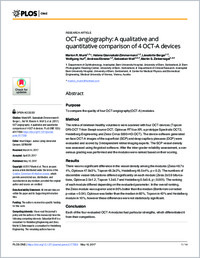OCT-angiography: A qualitative and quantitative comparison of 4 OCT-A devices.
- Munk MR Department of Ophthalmology, Inselspital, Bern University Hospital, University of Bern, Switzerland.
- Giannakaki-Zimmermann H Department of Ophthalmology, Inselspital, Bern University Hospital, University of Bern, Switzerland.
- Berger L Department of Ophthalmology, Inselspital, Bern University Hospital, University of Bern, Switzerland.
- Huf W Center for Medical Physics and Biomedical Engineering, Medical University of Vienna, Vienna, Austria.
- Ebneter A Department of Ophthalmology, Inselspital, Bern University Hospital, University of Bern, Switzerland.
- Wolf S Department of Ophthalmology, Inselspital, Bern University Hospital, University of Bern, Switzerland.
- Zinkernagel MS Department of Ophthalmology, Inselspital, Bern University Hospital, University of Bern, Switzerland.
- 2017-05-11
Published in:
- PloS one. - 2017
English
PURPOSE
To compare the quality of four OCT-angiography(OCT-A) modules.
METHOD
The retina of nineteen healthy volunteers were scanned with four OCT-devices (Topcon DRI-OCT Triton Swept-source OCT, Optovue RTVue-XR, a prototype Spectralis OCT2, Heidelberg-Engineering and Zeiss Cirrus 5000-HD-OCT). The device-software generated en-face OCT-A images of the superficial (SCP) and deep capillary plexuses (DCP) were evaluated and scored by 3 independent retinal imaging experts. The SCP vessel density was assessed using Angiotool-software. After the inter-grader reliability assessment, a consensus grading was performed and the modules were ranked based on their scoring.
RESULTS
There was no significant difference in the vessel density among the modules (Zeiss 48.7±4%, Optovue 47.9±3%, Topcon 48.3±2%, Heidelberg 46.5±4%, p = 0.2). The numbers of discernible vessel-bifurcations differed significantly on each module (Zeiss 2±0.9 bifurcations, Optovue 2.5±1.2, Topcon 1.3±0.7 and Heidelberg 0.5±0.6, p≤0.001). The ranking of each module differed depending on the evaluated parameter. In the overall ranking, the Zeiss module was superior and in 90% better than the median (Bonferroni corrected p-value = 0.04). Optovue was better than the median in 60%, Topcon in 40% and Heidelberg module in 10%, however these differences were not statistically significant.
CONCLUSION
Each of the four evaluated OCT-A modules had particular strengths, which differentiated it from their competitors.
To compare the quality of four OCT-angiography(OCT-A) modules.
METHOD
The retina of nineteen healthy volunteers were scanned with four OCT-devices (Topcon DRI-OCT Triton Swept-source OCT, Optovue RTVue-XR, a prototype Spectralis OCT2, Heidelberg-Engineering and Zeiss Cirrus 5000-HD-OCT). The device-software generated en-face OCT-A images of the superficial (SCP) and deep capillary plexuses (DCP) were evaluated and scored by 3 independent retinal imaging experts. The SCP vessel density was assessed using Angiotool-software. After the inter-grader reliability assessment, a consensus grading was performed and the modules were ranked based on their scoring.
RESULTS
There was no significant difference in the vessel density among the modules (Zeiss 48.7±4%, Optovue 47.9±3%, Topcon 48.3±2%, Heidelberg 46.5±4%, p = 0.2). The numbers of discernible vessel-bifurcations differed significantly on each module (Zeiss 2±0.9 bifurcations, Optovue 2.5±1.2, Topcon 1.3±0.7 and Heidelberg 0.5±0.6, p≤0.001). The ranking of each module differed depending on the evaluated parameter. In the overall ranking, the Zeiss module was superior and in 90% better than the median (Bonferroni corrected p-value = 0.04). Optovue was better than the median in 60%, Topcon in 40% and Heidelberg module in 10%, however these differences were not statistically significant.
CONCLUSION
Each of the four evaluated OCT-A modules had particular strengths, which differentiated it from their competitors.
- Language
-
- English
- Open access status
- gold
- Identifiers
-
- DOI 10.1371/journal.pone.0177059
- PMID 28489918
- Persistent URL
- https://folia.unifr.ch/global/documents/247132
Statistics
Document views: 24
File downloads:
- fulltext.pdf: 0
